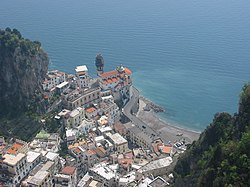Atrani
| Atrani | ||
|---|---|---|
| Comune | ||
| Comune di Atrani | ||

Panoramic view
|
||
|
||
 Atrani within the Province of Salerno |
||
| Location of Atrani in Italy | ||
| Coordinates: 40°38′N 14°37′E / 40.633°N 14.617°E | ||
| Country | Italy | |
| Region | Campania | |
| Province / Metropolitan city | Salerno (SA) | |
| Government | ||
| • Mayor | Nicola Carraro | |
| Area | ||
| • Total | 0.20 km2 (0.08 sq mi) | |
| Population (1 May 2009) | ||
| • Total | 931 | |
| • Density | 4,700/km2 (12,000/sq mi) | |
| Time zone | CET (UTC+1) | |
| • Summer (DST) | CEST (UTC+2) | |
| Postal code | 84010 | |
| Dialing code | 089 | |
| Patron saint | St. Mary Magdalene | |
Atrani is a city and comune on the Amalfi Coast in the province of Salerno in the Campania region of south-western Italy. It is located to the east of Amalfi, several minutes drive down the coast.
Atrani has a surface area 0.12 km2 making it the smallest community in all of Italy.
In 2010, the estimated population of Atrani was 913, making it the most densely populated city in the Salerno province.
The town is located between the Civita Hill and Aureo Hill. Atrani is along the valley of the river Dragone, named for a legend saying there once was a terrible dragon that would breathe fire and would hide himself there.
Because of the beauty of its alley, gardens, squares, buildings, characteristic “scalinatelle” (stairs) and for its overall atmosphere, Atrani has been used as a set for film commercials. In 2012 it was used as the backdrop for a Fiat commercial. Though it is part of the Amalfi Coast, it is the only town along the coast to preserve intact its antique, traditional characteristics.
The initial houses face the beach directly. They are grouped around the square and move around the church of San Salvatore and the marble fountain before going up towards the valley and climbing along the rocky mountain and crossing the gardens and the lemon fields. Atrani is isolated from automobile traffic because it is protected by its antique houses with flowered balconies. The central square of Atrani leads directly to the beach and the sea by crossing an antique passageway created to save boats from sea storms.
Atrani boasts a Mediterranean climate, with mild and rainy winters and summers that are moderately hot, very sunny and almost never foggy.
For the 30-year period from 1961 to 1990 the average temperature of the coldest month, January, was 10.7 degrees Celsius (51 degrees F); the temperature of the hottest month, August, was 26.8 degrees Celsius (80 degrees F).
The origins of Atrani are still unknown. Archeological research discovered ruins remaining from the 1st century AD. Roman villas existed along the Almafi Coast and were covered in debris from the eruption of Vesuvius in 79 AD. The debris was deposited on the mountains encircling Atrani and from there it was dumped into the valley. In the 5th century AD, barbarians attacked and numerous Romans escaped from the cities. They fled onto Monti Lattari and created stable settlements. The first documented proof of the existence of Atrani is represented by a letter by the Pope Gregory I to Bishop Pimenio of Amalfi dated 596 AD.
...
Wikipedia


